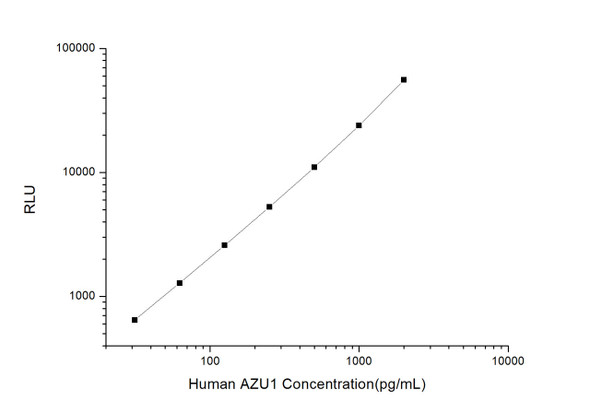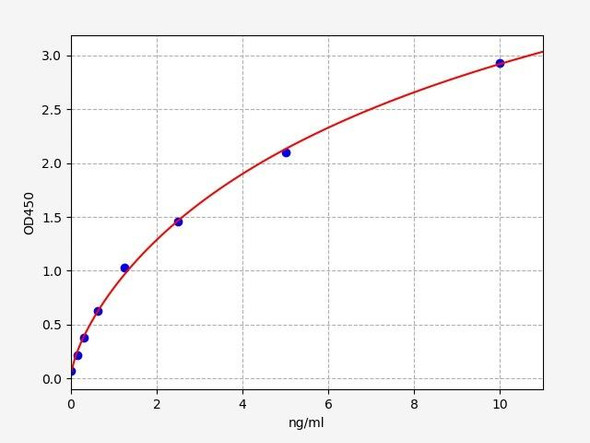Human Cell Biology ELISA Kits 2
Human AZU1 (Azurocidin 1) ELISA Kit (HUES01731)
- SKU:
- HUES01731
- Product Type:
- ELISA Kit
- Size:
- 96 Assays
- Uniprot:
- P20160
- Sensitivity:
- 0.09ng/mL
- Range:
- 0.16-10ng/mL
- ELISA Type:
- Sandwich
- Synonyms:
- AZAMP, AZU, CAP37, HBP, HUMAZUR, NAZC, Cationic Antimicrobial Protein CAP37, Heparin Binding Protein
- Reactivity:
- Human
- Sample Type:
- Serum, plasma and other biological fluids
- Research Area:
- Cell Biology
Description
| Assay type: | Sandwich |
| Format: | 96T |
| Assay time: | 4.5h |
| Reactivity: | Human |
| Detection Method: | Colormetric |
| Detection Range: | 0.16-10 ng/mL |
| Sensitivity: | 0.10 ng/mL |
| Sample Volume Required Per Well: | 100µL |
| Sample Type: | Serum, plasma and other biological fluids |
| Specificity: | This kit recognizes Human AZU1 in samples. No significant cross-reactivity or interference between Human AZU1 and analogues was observed. |
This ELISA kit uses Sandwich-ELISA as the method. The micro ELISA plate provided in this kit has been pre-coated with an antibody specific to Human AZU1. Standards or samples are added to the appropriate micro ELISA plate wells and combined with the specific antibody. Then a biotinylated detection antibody specific for Human AZU1 and Avidin-Horseradish Peroxidase (HRP) conjugate are added to each micro plate well successively and incubated. Free components are washed away. The substrate solution is added to each well. Only those wells that contain Human AZU1, biotinylated detection antibody and Avidin-HRP conjugate will appear blue in color. The enzyme-substrate reaction is terminated by adding Stop Solution and the color turns yellow. The optical density (OD) is measured spectrophotometrically at a wavelength of 450 nm ± 2 nm. The OD value is proportional to the concentration of Human AZU1. The concentration of Human AZU1 in samples can be calculated by comparing the OD of the samples to the standard curve.
| UniProt Protein Function: | AZU1: This is a neutrophil granule-derived antibacterial and monocyte- and fibroblast-specific chemotactic glycoprotein. Binds heparin. The cytotoxic action is limited to many species of Gram- negative bacteria; this specificity may be explained by a strong affinity of the very basic N-terminal half for the negatively charged lipopolysaccharides that are unique to the Gram-negative bacterial outer envelope. It may play a role in mediating recruitment of monocytes in the second wave of inflammation. Has antibacterial activity against the Gram-nagative bacterium P. aeruginosa, this activity is inhibited by LPS from P. aeruginosa. Acting alone, it does not have antimicrobial activity against the Gram-negative bacteria A. actinomycetemcomitans ATCC 29532, A. actinomycetemcomitans NCTC 9709, A. actinomycetemcomitans FDC-Y4, H. aphrophilus ATCC 13252, E. corrodens ATCC 23834, C. sputigena ATCC 33123, Capnocytophaga sp ATCC 33124, Capnocytophaga sp ATCC 27872 or E. coli ML-35. Has antibacterial activity against C. sputigena ATCC 33123 when acting synergistically with either elastase or cathepsin G. Belongs to the peptidase S1 family. Elastase subfamily. |
| UniProt Protein Details: | Chromosomal Location of Human Ortholog: 19p13. 3 Cellular Component: azurophil granule; extracellular region Molecular Function:heparin binding; toxin binding; serine-type endopeptidase activity Biological Process: positive regulation of tumor necrosis factor biosynthetic process; positive regulation of cell adhesion; microglial cell activation; glial cell migration; proteolysis; defense response to Gram-negative bacterium; macrophage chemotaxis; induction of positive chemotaxis; cellular extravasation; monocyte activation; positive regulation of phagocytosis; positive regulation of MHC class II biosynthetic process; positive regulation of fractalkine biosynthetic process; protein kinase C activation; positive regulation of interleukin-1 beta biosynthetic process; protein processing; immune response; regulation of vascular permeability; inflammatory response; negative regulation of apoptosis |
| NCBI Summary: | Azurophil granules, specialized lysosomes of the neutrophil, contain at least 10 proteins implicated in the killing of microorganisms. The protein encoded by this gene is an azurophil granule antibiotic protein, with monocyte chemotactic and antimicrobial activity. It is also an important multifunctional inflammatory mediator. This encoded protein is a member of the serine protease gene family but it is not a serine proteinase, because the active site serine and histidine residues are replaced. The genes encoding this protein, neutrophil elastase 2, and proteinase 3 are in a cluster located at chromosome 19pter. All 3 genes are expressed coordinately and their protein products are packaged together into azurophil granules during neutrophil differentiation. [provided by RefSeq, Dec 2014] |
| UniProt Code: | P20160 |
| NCBI GenInfo Identifier: | 416746 |
| NCBI Gene ID: | 566 |
| NCBI Accession: | P20160. 3 |
| UniProt Secondary Accession: | P20160,P80014, Q52LG4, Q9UCM1, Q9UCT5, |
| UniProt Related Accession: | P20160 |
| Molecular Weight: | 251 |
| NCBI Full Name: | Azurocidin |
| NCBI Synonym Full Names: | azurocidin 1 |
| NCBI Official Symbol: | AZU1 |
| NCBI Official Synonym Symbols: | AZU; HBP; NAZC; AZAMP; CAP37; HUMAZUR |
| NCBI Protein Information: | azurocidin; neutrophil azurocidin; heparin-binding protein; cationic antimicrobial protein 37; cationic antimicrobial protein CAP37 |
| UniProt Protein Name: | Azurocidin |
| UniProt Synonym Protein Names: | Cationic antimicrobial protein CAP37; Heparin-binding protein; HBP |
| Protein Family: | Azurocidin |
| UniProt Gene Name: | AZU1 |
| UniProt Entry Name: | CAP7_HUMAN |
As the OD values of the standard curve may vary according to the conditions of the actual assay performance (e. g. operator, pipetting technique, washing technique or temperature effects), the operator should establish a standard curve for each test. Typical standard curve and data is provided below for reference only.
| Concentration (ng/mL) | O.D | Average | Corrected |
| 10 | 2.298 2.316 | 2.307 | 2.215 |
| 5 | 1.622 1.632 | 1.627 | 1.535 |
| 2.5 | 0.855 0.849 | 0.852 | 0.76 |
| 1.25 | 0.436 0.472 | 0.454 | 0.362 |
| 0.63 | 0.295 0.283 | 0.289 | 0.197 |
| 0.32 | 0.202 0.174 | 0.188 | 0.096 |
| 0.16 | 0.137 0.147 | 0.142 | 0.05 |
| 0 | 0.083 0.101 | 0.092 | -- |
Precision
Intra-assay Precision (Precision within an assay): 3 samples with low, mid range and high level Human AZU1 were tested 20 times on one plate, respectively.
Inter-assay Precision (Precision between assays): 3 samples with low, mid range and high level Human AZU1 were tested on 3 different plates, 20 replicates in each plate.
| Intra-assay Precision | Inter-assay Precision | |||||
| Sample | 1 | 2 | 3 | 1 | 2 | 3 |
| n | 20 | 20 | 20 | 20 | 20 | 20 |
| Mean (ng/mL) | 0.48 | 1.25 | 4.58 | 0.49 | 1.16 | 4.74 |
| Standard deviation | 0.03 | 0.06 | 0.19 | 0.03 | 0.05 | 0.15 |
| C V (%) | 6.25 | 4.80 | 4.15 | 6.12 | 4.31 | 3.16 |
Recovery
The recovery of Human AZU1 spiked at three different levels in samples throughout the range of the assay was evaluated in various matrices.
| Sample Type | Range (%) | Average Recovery (%) |
| Serum (n=5) | 94-106 | 100 |
| EDTA plasma (n=5) | 88-98 | 93 |
| Cell culture media (n=5) | 89-100 | 94 |
Linearity
Samples were spiked with high concentrations of Human AZU1 and diluted with Reference Standard & Sample Diluent to produce samples with values within the range of the assay.
| Serum (n=5) | EDTA plasma (n=5) | Cell culture media (n=5) | ||
| 1:2 | Range (%) | 87-102 | 95-107 | 89-104 |
| Average (%) | 94 | 100 | 96 | |
| 1:4 | Range (%) | 86-99 | 86-100 | 87-100 |
| Average (%) | 93 | 92 | 92 | |
| 1:8 | Range (%) | 91-102 | 79-92 | 89-100 |
| Average (%) | 96 | 85 | 94 | |
| 1:16 | Range (%) | 92-106 | 81-92 | 86-97 |
| Average (%) | 99 | 87 | 92 |
An unopened kit can be stored at 4°C for 1 month. If the kit is not used within 1 month, store the items separately according to the following conditions once the kit is received.
| Item | Specifications | Storage |
| Micro ELISA Plate(Dismountable) | 8 wells ×12 strips | -20°C, 6 months |
| Reference Standard | 2 vials | |
| Concentrated Biotinylated Detection Ab (100×) | 1 vial, 120 µL | |
| Concentrated HRP Conjugate (100×) | 1 vial, 120 µL | -20°C(shading light), 6 months |
| Reference Standard & Sample Diluent | 1 vial, 20 mL | 4°C, 6 months |
| Biotinylated Detection Ab Diluent | 1 vial, 14 mL | |
| HRP Conjugate Diluent | 1 vial, 14 mL | |
| Concentrated Wash Buffer (25×) | 1 vial, 30 mL | |
| Substrate Reagent | 1 vial, 10 mL | 4°C(shading light) |
| Stop Solution | 1 vial, 10 mL | 4°C |
| Plate Sealer | 5 pieces | |
| Product Description | 1 copy | |
| Certificate of Analysis | 1 copy |
- Set standard, test sample and control (zero) wells on the pre-coated plate and record theirpositions. It is recommended to measure each standard and sample in duplicate. Note: addall solutions to the bottom of the plate wells while avoiding contact with the well walls. Ensuresolutions do not foam when adding to the wells.
- Aliquot 100 µL of standard solutions into the standard wells.
- Add 100 µL of Sample / Standard dilution buffer into the control (zero) well.
- Add 100 µL of properly diluted sample (serum, plasma, tissue homogenates and otherbiological fluids) into test sample wells.
- Cover the plate with the sealer provided in the kit and incubate for 90 min at 37 °C.
- Aspirate the liquid from each well, do not wash. Immediately add 100 µL of BiotinylatedDetection Ab working solution to each well. Cover the plate with a plate seal and gently mix. Incubate for 1 hour at 37 °C.
- Aspirate or decant the solution from the plate and add 350 µL of wash buffer to each welland incubate for 1-2 minutes at room temperature. Aspirate the solution from each well andclap the plate on absorbent filter paper to dry. Repeat this process 3 times. Note: a microplatewasher can be used in this step and other wash steps.
- Add 100 µL of HRP Conjugate working solution to each well. Cover with a plate seal andincubate for 30 min at 37 °C.
- Aspirate or decant the solution from each well. Repeat the wash process for five times asconducted in step 7.
- Add 90 µL of Substrate Reagent to each well. Cover with a new plate seal and incubate forapproximately 15 min at 37 °C. Protect the plate from light. Note: the reaction time can beshortened or extended according to the actual color change, but not by more than 30min.
- Add 50 µL of Stop Solution to each well. Note: Adding the stop solution should be done inthe same order as the substrate solution.
- Determine the optical density (OD value) of each well immediately with a microplate readerset at 450 nm.






